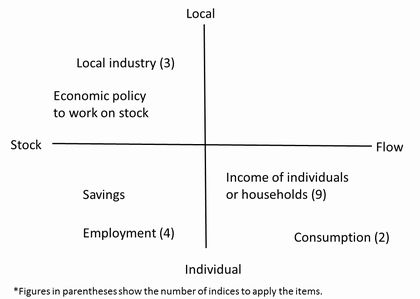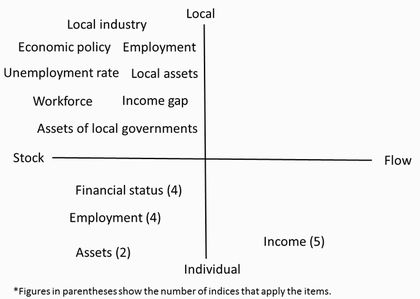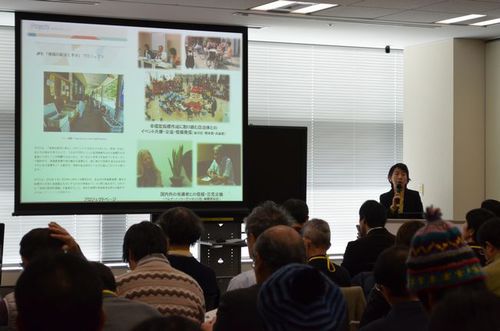February 27, 2014
Review and Future Directions of JFS's Local Well-Being Project
Keywords: Civil Society / Local Issues Newsletter Well-Being
JFS Newsletter No.138 (February 2014)
In 2013, JFS worked on the development of local indicators of well-being as one of its themes. This issue of the JFS Newsletter presents the content of a presentation about the one-year research outcomes of the JFS "Local Well-Being Project" at the "Thinking about Happiness at the Local Level" symposium, which was held February 6, 2014 in Tokyo.
The idea and practice of "happiness can't be measured by gross domestic product (GDP)," has become a large trend in Japan, as well as around the world. Many movements trying to measure true affluence and well-being are also being developed locally in Japan.
Creating Happier Communities: Over 22 Local Governments in Japan Preparing a "Happiness Index" to Measure Progress
http://www.japanfs.org/en/news/archives/news_id032301.html
The traditional definition of GDP is the "total added values of goods and services newly produced domestically and traded in the market." Since it needs to be "traded in the market," the vegetables grown in a garden, then brought to and sold at the market will be counted in the GDP. On the other hand, extra home-grown vegetables shared with neighbors are not counted because the exchange is not market-based.
Tetsuro Yoshimoto, in the city of Minamata, Kumamoto Prefecture, promotes "jimoto-gaku" (community study) across Japan. He often mentions that there are three types of economies: the money-economy, based on exchanging money; the self-sufficiency economy created on our own; and the barter economy, based on receiving and sharing. Needless to say, GDP only measures the money economy.
"Jimoto-Gaku," Community Studies for Creating and Maintaining Harmony in
Society, Nature and Industry
http://www.japanfs.org/en/news/archives/news_id027966.html
To Start Where We Are --Restoring a Negative Heritage Using Social Capital
http://www.japanfs.org/en/projects/sus_college/sus_college_id033817.html
Another characteristic of GDP is to measure newly produced goods and services. What matters is "how much was produced and sold in the market this year." The vegetables grown in a garden and harvested during the year will be counted in GDP, but the soil that the vegetables grew in has nothing to do with GDP. In short, GDP measures flow, not stock.
A flow is created because of a stock. In other words, vegetables grow with rich soil. But GDP only measures flow (this year's harvest), ignoring the abundance of stock (soil). For an extreme example, GDP becomes positive if a lot of chemical fertilizers, agricultural chemicals, and pesticides are used and the production volume of the particular year is substantially increased. But the negative influence over stock, such as crop failure due to poor soil in the following year, will not be shown in GDP. It is very important to distinguish between stock and flow.
The Report by the Commission on the Measurement of Economic Performance and Social Progress (Stiglitz Report), published in 2009, has twelve recommendations. Recommendation 3 is: "Consider income and consumption jointly with wealth." It advises that we should consider wealth as a stock with the flow of income and consumption.
Report of the Commission of the Measurement of Economic Performance and
Social Progress
http://www.stiglitz-sen-fitoussi.fr/documents/rapport_anglais.pdf
The Inclusive Wealth Index (IWI), first announced at the United Nations Conference on Sustainable Development (Rio+20) in June 2012, is part of an attempt to measure stocks. The IWI calculates assets to include manufactured (e.g., roads, machinery, infrastructure), human (e.g., education and skills), and natural (e.g., land, forests, oil, minerals) capitals. Japan is almost losing the lead to other countries in flow, GDP, but ranks second following the U.S. in the total amount of IWI, achieving the top IWI position in the world on a per-capita basis.
Inclusive Wealth Report 2012
http://www.ihdp.unu.edu/article/iwr
Imagine a bathtub when thinking about "stock" and "flow." The water coming in from the tap is "inflow" and that draining out of a pipe is "outflow," while "stock" is the water accumulated resulting from the gap between the inflow and the outflow. Stock itself cannot be changed, so we need to instead change inflow or outflow. For example, to increase employment (stock), it is necessary to increase newly employed population (inflow) or decrease the number of displaced workers (outflow).
Another important point is to distinguish between the two kinds of flow -- one is to enrich stock, the other to exhaust stock. Take the example mentioned above. The agricultural produce with harm to soil (flow) is the flow to exhaust the stock, while those grown in a way to improve the quality of soil, such as organic farming, is the flow to enrich the stock.
From this perspective, we researched various happiness indices in Japan and overseas. Analyzing those indices to measure happiness, including the economic perspective, we plotted them on a biaxial graph -- with one axis of individual to local and one of stock to flow.
Although it is still a tentative analysis, the findings of our research on 16 local happiness indices in Japan are shown, as follows. Seven out of 10 indices that surveyed residents' awareness contained economic components. We collected and categorized all questions with economic components and then plotted in Figure 1. We found many of them measure income.

Figure 1 Analysis: Indices in Japan (tentative)
Among overseas indices, five of them with local awareness are plotted in Figure 2. Many of them measure stocks of individuals, such as employment and assets, while many measure individuals' flow by income. Many indices also measure local stock by local buildings, assets, and industry.

Figure 2 Analysis: Overseas indices (tentative)
Generally, we found a tendency to measure stock rather than flow. This is understandable, though, considering that they may be alternatives to GDP that measure flow. According to our research, to analyze happiness indices measured by resident awareness surveys, no index measures flow that leads to local stock, nor distinguishes flow from the perspective of whether it enriches or exhausts stock.
One more important thing to think of from the economic aspect is to consider the possibility that flow could influence multi-layered stocks when money flows. According to one sociological survey, a person who shops at a local farmers market has 10 times more conversations than one who shops at a supermarket. Even though it is the same in that money flows through their shopping activities, it must be different in the effect, such as smiles, happiness, a sense of trust and safety, as well as ties to the local community, if conversations through shopping at local markets happen 10 times more than shopping at supermarkets. Therefore we would like to consider the potential to increase any flows that lead to more happiness, not just movement of money.
Local governments often invite manufacturing companies to locate in their jurisdictions in order to energize the local economy. Even after the invitation was successful and some money started to enter the area, the money will go out to another area or abroad at the next moment, because product components are made outside the region and employees of the factory buy products made outside the area with their salary. The money could just go through the local community. It is important to note how much money will remain and circulate within the area, not just how much money would enter the area.
One approach to make this visible is the local multiplier effect. Assume that 10,000 yen (about U.S.$9,700) of money enters a community. Then compare two cases: one is that 80 percent of the amount is used within the community via buying something at the local shops; the other is that only 20 percent of it would remain within the area. In the end, there will be a nearly five-fold difference between the two cases.
Thus, it is important to recycle the money locally as much as possible by plugging the leaks of a "leaky bucket," because if you pour water into the leaky bucket, the water will not remain in the bucket (meaning a local community). In the transition town of Totness, in the U.K., a research project is underway to study the effects of money used and recycled within the town, which otherwise often goes out of the area.
Plugging the Leaks
http://www.pluggingtheleaks.org/
In Japan, a large amount of money is leaking from the regions and the country in exchange for food and energy. A book, titled "Satoyama Capitalism," has become one of the best-selling books in Japan, which introduces the idea and some examples of how to recycle money in the local community as much as possible.
In this regard, in a greeting from Akita Prefecture Governor Norihisa Satake at the beginning of the year 2014, it was very interesting to note that he said, "When it comes to local employment, every local government has tried to invite manufacturing industries to move to their region, but the practice is obsolete." This means that depending on the outside economy will not work anymore, because the money will leak from the community. So how to use local resources and recycle them within the area becomes much more important.
When thinking about local well-being from the economic aspect, the following questions came to me: What kind of local flow can enhance local stocks? How long will the money that enters an area keep recycling within it? Beyond the local economic benefits, what can be generated by recycling the money? And how do we measure these?
In addition, some actual initiatives aiming at local economy and well-being started to emerge, such as the "Slow Money Movement" (meaning investment in local businesses) and "Community Supported Industry (CSI)" (an industrial version of Community Supported Agriculture, or CSA). Very interesting movements have started to be seen all around the world.
In our next project, we go into greater depth with our findings on how the local economy and well-being interconnect with each other and how to measure them, by studying and introducing such initiatives from abroad. I hope we will be able to build a framework based on the findings, which can then be used for creating well-being indices and the initiatives of local communities and governments.
How can local economies support happiness? Japan for Sustainability
invites your comments and discussion below.
Written by Junko Edahiro
Related
"JFS Newsletter"
- 'Good Companies in Japan' (Article No.4): 'Eightfold Satisfaction' Management for Everyone's Happiness
- "Nai-Mono-Wa-Nai": Ama Town's Concept of Sufficiency and Message to the World
- 'Yumekaze' Wind Turbine Project Connects Metro Consumers and Regional Producers: Seikatsu Club Consumers' Co-operative
- Shaping Japan's Energy toward 2050 Participating in the Round Table for Studying Energy Situations
- 'Good Companies in Japan' (Article No.3): Seeking Ways to Develop Societal Contribution along with Core Businesses



